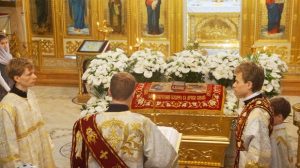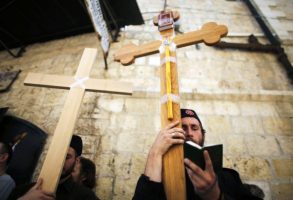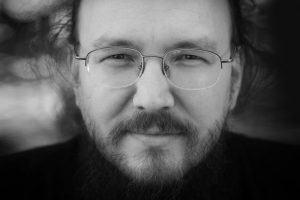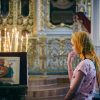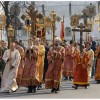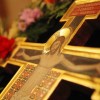On Passover night, lambs were supposed to be slaughtered and eaten. A Passover meal had to include a roasted lamb. But the rules of Kashrut (that which is allowed by Judaism) mandate that meat must not contain any blood. According to Josephus Flavius, 265 thousand lambs were slaughtered in Jerusalem for Passover. Herod Agrippa, in order to estimate the number of pious families, ordered that the number of sacrifices should be counted; they turned out to be 600 thousand… And it was necessary to drain all blood from all these hundreds of thousands of animals. If one keeps in mind that Jerusalem did not have a sewer system, one can imagine the amount of blood flowing down the city’s streets toward the stream of Kedron.
Kedron is located between the city wall and the Garden of Gethsemane where Christ was arrested. In the days before Passover, the stream of Kedron was filled, not so much with water, but with blood. Before our eyes is a symbol born out of the very reality: Christ, the New Testament Lamb, is led to His execution across a river which is filled with the blood of the Old Testament lambs. He came to spill His blood, so that there would no longer be a need to spill anyone else’s. The entire horrific might of the Old Testament cult could not seriously heal a human soul. “No one will be justified by the works of the Law…”
The passions of Christ begin in the Garden of Gethsemane. Here, He spent the last hours of His earthly life in prayer to the Father.
Luke the Evangelist, a physician by education, describes the image of Christ in these minutes with precision. He says that when Christ prayed, blood ran down His face like drops of sweat. This phenomenon is known to medicine. When a person is in a state of extreme nervous or psychological tension, then sometimes—quite rarely—this happens. The capillaries that are closest to the skin burst, and blood enters into sweat glands and mixes with sweat. In this process, large drops of blood can indeed form and run down a person’s face. When this happens, the person is severely weakened. And it is at this moment that Christ is arrested. The Apostles attempt to resist. Apostle Peter, who carried a “sword” with him (perhaps it was just a large knife), is ready to use this weapon to defend Christ, but hears from the Savior: “Put your sword back into its place; for all who take the sword will perish by the sword. Do you think that I cannot appeal to my Father, and he will at once send me more than twelve legions of angels?” The Apostles scatter. Having just been awakened, no one is ready to follow after Christ. And only one of them, hiding in the bushes, follows the temple guards who are leading Christ into the city. He is Mark the Evangelist, who will later recount this episode in his Gospel. While Christ prayed in the Garden of Gethsemane, the Apostles slept, despite Christ’s pleas that they not. In those days, it was customary to sleep naked, and Mark had no clothes on. When he jumped up, the young man hurriedly threw something over his body, and in this manner followed after Christ. He was spotted in the bushes, and the guards tried to catch him, so Mark was forced to leave his cloak in the hands of the guards and to run away naked (Mk. 14:51). This episode is worth mentioning because in essence it had been prophesied in the Old Testament. In the Book of the Prophet Amos (2:16), it was written about the day of the coming of the Messiah: “And those who are stout of heart among the mighty shall flee away naked in that day…” Mark indeed turned out to be the bravest—he was the only one who tried to follow after Christ—but he still had to run away naked from the guards…
When Christ is betrayed by Judas, He is arrested by the guards of the Sanhedrin, the highest governing organ of the Judean religious community. He is taken to the house of a high-priest for hasty judicial proceedings that employed false witnesses and false accusations. Trying to silence the conscience of those present, the high-priest says: “… it is better for you to have one man die for the people than to have the whole nation destroyed.” The Sanhedrin wishes to show the Roman rulers that it can tame the “troublemakers” on its own in order to give the Romans no reason for repressions.
The events that follow are described in the Gospel in detail. High-priests reached a verdict. The Roman procurator (locum tenens) Pontius Pilate does not find Jesus guilty of any charge presented by the Sanhedrin: “Corruption of the people, refusal to pay taxes to Caesar, the Roman Emperor, attempts to seize power over the Jewish people.” The high-priest Caiaphas, however, insisted on an execution, and eventually, Pilate agrees.
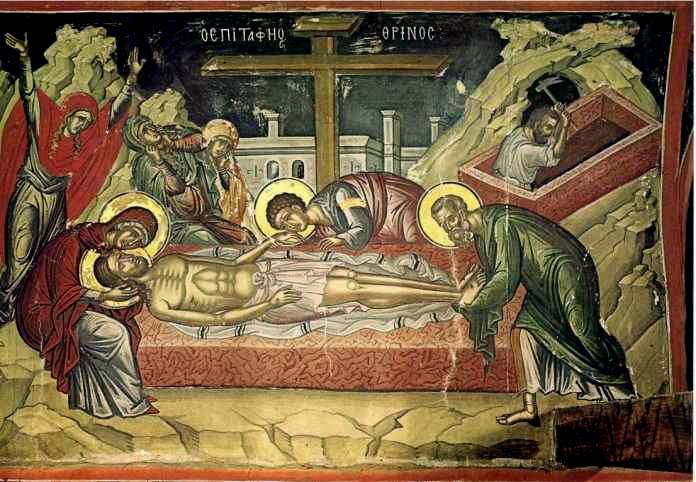
Note the part in the sentence where the Sanhedrin says: “He makes Himself God.” Thus, even those who were not at all sympathetic to Christ’s preaching thought that He made Himself equal to God, asserted for Himself divine dignity. Therefore, it was only natural that in the eyes of pious Jews who confessed the oneness of God, this was true blasphemy—but not at all calling oneself the Messiah. For example, Bar Kaaba, who around the same time also contested a messianic title, was not crucified, and his fate was much better. So, the sentencing is over and thus begins the night before the execution.
Golgotha, a small hill outside of the Jerusalem city walls, was a traditional place for public executions. It is for this purpose that several posts always stood at the top of that hill. Customarily, the one to be crucified had to carry a heavy beamfrom the city which served to make a cross. It was such a beam that Christ also had to carry, but as the Gospel says, could not take it all the way to Golgotha. He was too weak. Prior to this, Christ had already been punished once: He was flogged.
Today, based on information gleaned from studying the Shroud of Turin, we can say that flogging consisted of thirty-nine lashes with a scourge which had five thongs with lead balls tied at the end of each. During the beating, the scourge wrapped around the body and cut skin to the bone. Jesus received thirty-nine lashes because the Jewish law did not allow more than forty to be given. This was considered a capital punishment.
However, the law had already been broken. Christ was punished twice, while any law, including Roman law, forbidmore than one punishment for the same crime. Flogging was the first and the worst punishment. Not everyone survived it. Nonetheless, after this first punishment followed a second one—crucifixion. It appears that Pontius Pilate really tried to spare Jesus’ life and hoped that the sight of the Preacher who was beaten nearly to death and all covered in blood would satisfy the blood-thirsty instincts of the crowd.
This, however, did not happen. The crowd demanded an execution, and Jesus was led to Golgotha. Beaten and weakened, He fell along the way several times, and in the end the guards forceda peasant by the name of Simon, who was standing nearby, to take the cross and carry it the rest of the way. On Golgotha, the Lord is nailed to the cross. His feet are nailed to the post which is already there, and His hands to the beam which He carried; and then the beam is lifted up onto the post and nailed.
Over the course of two thousand years, the word “crucifixion” has been repeated so many times that its meaning is often lost to some degree, became less vivid. The enormity of the sacrifice given by Christ for all people—those who were and those who will be—has become less vivid in the minds of those living today.
So, what is crucifixion? Cicero called this punishment the most horrific of all invented by humans. Its essence is that a human body is hung on a cross in such a way that the center of gravity is in the chest. When the arms are raised above the shoulders and the person cannot find support in his legs, then the entire weight of the body rests in the chest. As a result of this tension, blood floods the chest muscles and stagnates in them. The muscles gradually begin to stiffen. Then comes asphyxiation: cramped chest muscles put pressure on the chest. The muscles do not allow the diaphragm to expand; the person cannot fill his lungs with air and begins to suffocate to death. Such an execution sometimes took several days. In order to speed it up, a person was not simply tied to the cross, but often nailed. Forged nails with ridges were pounded between the radius and ulna near the wrist. On its path, the nail met a bundle of nerves. By itself, touching a bare nerve causes horrible pain; here, these nerves were crushed. But this is not all. In order to breathe in this position, the person must find a fulcrum in his own body in order to free the chest for breathing. For a nailed person, the only fulcrum is his own feet which are also nailed through. The nail enters between the small bones of the foot. The man must push against the nail which goes through his foot, strengthen his knees, and lift up his body, thus relieving the pressure on the chest. Then he can take a breath. But because his arms are also nailed through, they begin to pivot around the nails. In order to take a breath, the man must pivot his arm around the nail, which is not smooth but covered with ridges and burrs. Such a movement is accompanied by pain on the verge of shock.
The Gospel tells us that Christ was on the cross for approximately six hours. In order to speed up the execution, the guards often broke the legs of the crucified with a sword at the ankles. The person then lost his last support and quickly suffocated. The guards who were on Golgotha on the day of Christ’s crucifixion were in a hurry. They had to finish their horrible deed before sunset because Judean law did not allow the handling of dead bodies after sunset, but they could not be left until the next day due to the approach of a great holiday, the Judean Passover, and three dead bodies could not be left hanging over the city. Thus, the team of executioners is in a hurry. Saint John specifies that the soldiers broke the legs of the two robbers who were crucified with Christ, but they did not touch Christ because they saw that He had already died. Thisis not difficult to see when a person is on the cross. As soon as the man stops constantly moving up and down, this means that he is no longer breathing, and thus he has died…
Luke the Evangelist tells us that when a Roman centurion pierced Jesus’ chest with a spear, blood and water came from the wound. According to doctors, this is a reference to the liquid which came from the pericardium. The spear pierced the chest from the right, all the way to the pericardium and the heart—this a professional strike of a soldier who aims at the side of the body which is unprotected by a shield and strikes directly at the heart. Blood cannot flow from a dead body. The fact that blood and water flowed from the wound means that earlier, before the last strike, blood mixed with the liquid in the pericardium. The heart could not bear the suffering. Christ died earlier from a ruptured heart.
They manage to take Christ off the cross before sunset, quickly wrap Him in a burial shroud, and put Him in a tomb. This is a stone cave which is cut in a rock near Golgotha. They put Him in the tomb, seal the entry into the small cave with a heavy stone, and place guards to ensure that the disciples not steal the body. Two nights pass and one day, and on the third day, when, full of sorrow at the loss of their beloved Teacher, the disciples go to the tomb in order to finally wash His body and complete all of the burial rites, they find that the stone is moved away, the guards are gone, and the tomb is empty. But just as their hearts were about to be filled with new sorrow—not only was their Teacher killed, but now they don’t even have the chance to properly bury Him—at this moment, an Angel appears to them and proclaims the greatest news: Christ is risen!
The Gospel describes several meetings with the risen Christ. It is amazing that after His resurrection Christ does not appear to Pontius Pilate of Caiaphas. He does not go to convince those people who did not recognize Him during His life. He appears only to those who believed and accepted Him before. This is a miracle of God’s respect for human freedom. And when we read the testimony of the Apostles about the resurrection of Christ, we are impressed by one detail: they do not tell of the resurrection as an event which happened somewhere to some other person, but as an event in their personal lives. And it is not something like: “Someone dear to me was raised from the dead.” No. The Apostles say: “We have been raised together with Christ.” From that time forward, every Christian can say that the most important event in his or her life happened in the days of Pontius Pilate, when the stone sealing the entrance to the tomb was found moved away and out came the Conqueror of death.
The Cross is the main symbol of Christianity. The Cross is the focus of sorrow. But the Cross is also the protection and the source of joy for a Christian. Why was the Cross necessary? Why were Christ’s sermons and His miracles not enough? Why was it not enough for our salvation and union with God that God, the Creator, became man, a creature? Why, in the words of Saint Gregory the Theologian, did we have a need not only of an incarnated God but also for a sacrificed One? What is the meaning of the Cross of the Son of God in the context of the relationship between man and God? What happened on the Cross following the crucifixion?
Christ said many times that He came into the world specifically for this moment. The last enemy, the ancient enemy against whom Christ battles, is death. God is life. All that exists, all that lives, according to Christianity and to the experience of any developed religious and philosophical thought, exists and lives through its participation in God, its connection with Him. But when a person sins, he destroys this connection. Then divine life no longer flows in him, no longer nourishes his heart. The person begins to “suffocate.” The person, as the Bible sees him, may be compared to a diver who is working on the bottom of the sea. Suddenly, because of some careless move, the hose which supplies oxygen from the surface becomes constricted. The man begins to die. In order to save him, it is necessary to restore the supply of oxygen from the surface. This process is the essence of Christianity.
Such a careless move which destroyed the connection between man and God was the original sin and all of the personal human sins that followed. People erected a barrier between themselves and God—not a spatial barrier, but a barrier in the heart. People became cut off from God. This barrier had to be removed. In order for people to be saved and to attain immortality, it was necessary to restore the connection with Him, Who is the only immortal One. In the words of the Apostle Paul, only God has immortality. People fell away from God, from life. They had to be “saved,” they had to be helped to acquire God—not some middleman, not a prophet, not a teacher, not an angel, but God Himself. Could people have built such a ladder of their merits, their good deeds, which would allow them, like the stairs of the Tower of Babel, to climb to heaven? The Bible gives a clear answer: no. Then, since the Earth cannot ascend to Heaven, Heaven comes down to Earth. Then God becomes man. “The Word became flesh.” God came to people. He did not come to find out how we live or to give us some advice about how to behave. He came in order that human life could unite with Divine life, could commune with it. Christ takes everything that is in human life, except sin, into Himself. He takes a human body, a human soul, a human will, human relationships—in order to warm man within Himself, to change him.
But there is one more property that is inseparable from the term “human.” During the epochs that passed since the expulsion from Paradise, man acquired one more skill; he learned to die. And God decided to also take into Himselfthis experience of death.
People have tried to explain the mystery of Christ’s suffering on Golgotha in different ways. One of the simplest schemes says that Christ gave himself as a sacrifice instead of us. The Son decided to please the Heavenly Father, so that the latter would forgive all people in light of the Son’s enormous sacrifice. This was the opinion of Western medieval theologians; often this is taught by popular Protestant preachers, and one can find such opinions even in Apostle Paul’s writings. This scheme comes from the worldview of a medieval man. In the archaic and medieval world, the gravity of a transgression depended on the person against whom the transgression was committed. For example, there is one punishment for killing a peasant, but a more serious punishment for killing a prince’s servant. It is in this way that medieval theologians often tried to explain the meaning of biblical events. In and of itself, Adam’s transgression was not very serious—he took an apple, that’s all—but the problem is that this was a transgression against the greatest ruler, against God.
A small, in itself miniscule, transgression, multiplied by Infinity against which it was committed, also became infinite. And respectively, in order to pay this infinite debt, there was a need of an enormous sacrifice. Man was not able to give this sacrifice for himself; thus, God gave this sacrifice in our behalf. Such an explanation fully agreed with a medieval mindset.
Today, we cannot find this scheme sufficiently sensible. In the end, we are left with a question: is it just that an innocent person is punished instead of the real perpetrator? Is it just if one person quarrels with his neighbor, but then when his heart softens, he decides: alright, I will no longer be angry with my neighbor, but in order to fulfill the law, I will go and slaughter my son, and then we will consider that the quarrel is over?
In fact, challenges to such popular theology were mounted by the Holy Fathers of the Orthodox Church. Here is, for example, the reasoning of Saint Gregory the Theologian: “It is now left for us to investigate the question and dogma which is left by many without attention, but which I see as requiring much investigation. To whom and for what was spilled the blood that was spilled for us—the great and most glorious blood of God, and High-Priest, and Sacrificial Lamb? We were ownedby the evil one, sold to sin, and with our voluptuousness we bought our own corruption. And if a ransom is paid to the one who owns, I ask: to whom and for what reason was such a ransom paid? If to the evil one, then how offensive this is! A robber receives the price of redemption, receives not only from God, but receives God Himself; for his torment he takes such an infinite ransom that it was enough to spare us! And if [the ransom is paid] to the Father, then first, why is the blood of the Only-Begotten pleasing to the Father, Who did not accept Isaac offered by [his] father, but replaced the sacrifice, giving a ram in place of reasonable sacrifice? Or, can we see from this that the Father accepts not because He had a need, but according to economy, and because man had to be sanctified by the humanity of God, that He Himself would redeem us by overpowering the tormentor, and that [He] would raise us up to Himself through the Son Who mediates and completes everything for the glory of the Father, Whom He obeys in everything? Such are the works of Christ, and what is beyond should be honored by silence.”
There were other attempts at explaining Golgotha. One of the schemes, a deeper and daring one in a way, speaks of a trickster who has been tricked. Christ is likened to a hunter. When a hunter wants to catch some animal or fish, he puts out bait or masks the hook with a lure. A fish takes that which it sees and find that with which it did not want to meet.
According to some Eastern theologians, God comes to earth in order to destroy the dominion of Satan. What is the dominion of death? Death is emptiness, non-existence. Therefore, it is impossible to simply chase death away. Death can only be filled from within. Destruction of life cannot be overcome by anything but creation. In order to enter into this emptiness and fill it from within, God took upon Himself the image of man. Satan did not learn the mystery of Christ, the mystery of the Son of God Who became man. He considered Him merely a righteous man, a saint, or a prophet, and thought that as any son of Adam, Christ is subject to death. And at the moment when the powers of death rejoiced that they were able to defeat Christ, expecting tomeet another human soul in hell, they met with the power of God Himself. This divine lightning comes down into hell, begins to unfold there, and destroys the entire crypt of hell. This is one of the images which is rather popular in ancient Christian literature.
The third image likens Christ to a physician. Saint Basil the Great says it in just these words: before sending His Son down to earth, God absolved all our sins. Christ comes as an experience physician in order to put together the broken human nature. By themselves, humans must take down all the barriers from within their own nature which separate them from God. In other words, humans must learn to love, but love is a very dangerous feat. In love, man loses himself. In some way, serious love is akin to suicide. Man stops living for himself and begins to live for another whom he loves—otherwise, it is not love. Man goes beyond himself.
However, each person has some part which does not want to go beyond itself. It does not want to die in love, it prefers to see everything from the perspective of its own little benefit. With this part, begins the death of the human soul. Could God have cut out this cancerous tumor which dwells in the human soul with an angelic scalpel? No, He could not. He created humans to be free (in His image and likeness) and would not corrupt His own image which He put into man. God acts only from within man, only through man. Two thousand years ago, the Son of the pre-eternal Father became the son of Mary in order for there to be at least one soul in this human world which could say to God: “Yes, take me, I do not want to have anything of my own. Your will be done, not mine.”
Then begins the sacrament of the divinization of the human nature of Christ. He is God from His very birth. On one hand, He possesses the divine consciousness, the divine “I am,” but on the other hand, He possesses a human soul which developed in the same way as any other child’s, youth’s, or man’s. Naturally, God instilled a fear of death in every living creature. Death is that which is not God. God is life. Every human soul, every living soul, naturally fears that which is most obviously not God. Death is most obviously not God. And Christ’s human soul has the fear of death—it does not cower, nor does it resist death. This is why in the Garden of Gethsemane, the human will and soul of Christ address God with the words: “I am deeply grieved, even to death… if it is possible, let this cup pass from me; yet not what I want but what you want” (Matt. 26:38-9).
At this moment falls the last barrier which could separate man from God—the experience of death. As a result, when death comes to Christ’s life and attempts to break and destroy it, death finds no material for itself. By the definition of Saint Irenaeus of Lyons, agreed upon not only by the second-century Christians, the saint’s contemporaries, but also by the faithful of all times, death is a break. First of all, it is a break between soul and body, and also the second death, which in Christian terminology is a break between the soul and God. Eternal death. Thus, when this break, this split, tries to establish itself in Christ, to find a place in Him, it turns out that it has no place there. It gets stuck there because through the prayer at Gethsemane, Christ’s human will completely submitted to the divine will, united with it. The wedge of death could not separate Christ’s soul from the Divine nature of the Son of God, and as a result, Christ’s human soul remained to the end inseparable from His body. And this is why there is an almost immediate resurrection.
For us this means that from now on, human death is reduced to merely an episode in human life. Since Christ found a way out of death, this means that if a man follows Him, figuratively speaking “clings to His clothes,” then Christ will drag him through the corridors of death. And death will turn out to be a door, not a dead end. It is because of this that the Apostles say that the death of Jesus Christ is the most important event in their personal lives.
Therefore, we attain salvation not through the death of Christ, but through His resurrection. Death is chased out by the force of life. Christ does not merely “suffer” passions. No. He invades the dominion of death and grafts humanity to the source of eternal life—God.
There is also a fourth image that explains the events of Golgotha. The Earth where people live can be likened to a besieged planet. It so happened that in the heavenly realm at a time about which we know nothing, an act of apostasy took place…
We do not know its motives, we do not know how it happened, but we do know its consequences. We know that there was a division in the angelic world. Some number of the heavenly spiritual hosts refused to serve the Creator. From a human point of view this is easy to understand. Any being that recognizes itself as a person sooner or later faces a dilemma: to love God more than self, or to love self more than God. There was a time when the angelic world faced that choice. Most of the angels—as is supposed in both the biblical and Church experience—“stood firm” in purity and “stood firm” in God, but some number of them fell away. Among them was the angel who had been created the most beautiful, the wisest, and the strongest. He was given a marvelous name—Light-Bearer (Lat.—“Lucifer”; Slav.—“Денница”). He was not merely one of the singers of God’s glory. God entrusted him as ruler over the entire Universe.
According to the Christian worldview, each person and each nation has its own Guardian Angel. Lucifer was the Guardian Angel of the whole Earth, the entire human world. Lucifer was the “ruler of the Earth,” the ruler of this world.
From the first pages, the Bible shows us that the most horrible events in the cosmic chronicle happen because of man. From the point of view of geology, man is nothing but mold on the surface of an insignificant celestial body located on the edge of the Galaxy. From the point of view of theology, man is so important that it was because of him that a war was sparked between God and Lucifer. The latter thought that in his dominion people must serve the master of this dominion. In other words, [they should serve] him, Lucifer.
Unfortunately, through original sin, man let evil into his world, and the world was separated from God. God could speak to people to remind them of His existence. The whole tragedy of the pre-Christian world can be expressed through a simple phrase: “there was God, and there were people,” and they were apart, and between them was some thin, invisible, but very resilient wall that did not allow a human heart to really unite with God, that did not allow God to always stay with people. And so Christ comes in the image of a servant, as a carpenter’s son. God comes to people in order to raise “from within” a rebellion against the usurper. If one reads the Gospel carefully, then it becomes clear that Christ is not such a sentimental preacher as He may appear to us today. Christ is a warrior, and He says directly that He fights a war against an enemy who He calls “the ruler of this world” (John 12:31)—“arhontoukosmou.” If we carefully look at the Bible, we will see that the Cross and Golgotha are the price of humandabbling in the occult, their passion for “cosmic revelations.”
A further reading of the Bible will reveal another interesting mystery. In popular mythological thinking, demons dwell in a subterranean place. Folk understanding places hell under the earth, in a place of boiling magma. Rather, the Bible says that the “spiritual forces of evil” dwell in the heavenly places. In fact, they are called “the spiritual forces of evil in the heavenly places,” not “subterranean” ones. It turns out that the world which people customarily call “the visible heaven” is not at all safe; it strives to enslave the human heart. “Forget about God, pray to me, my rewards are more certain!”—thus spoke a demon in Zhukosvky’s ballad “Gromoboi.” Christ wants to break through this aerial blockade. For this He comes here incognito, and for this He dies.
Saint Maximus the Confessor asks: “Why did Christ choose such a horrible kind of execution?”—and offers an answer: “in order to cleanse the aerial essence.” As Saint Maximus the Confessor explains, Christ dies in the air, not on earth, in order to abolish “the enemy powers which fill the middle place between heaven and earth.” The Cross sanctifies the “aerial space”—in other words, that space which separates people from Him Who is above the heavens. So, after Pentecost, the first martyr Stephen sees the heavens opened, and through this opening he sees “Jesus standing at the right hand of God” (Acts 7:56). The Cross of Golgotha is a tunnel punched through the thicket of demonic powers which aim to present themselves to man as the latest religious reality.
Therefore, if man is able to reach the zone which Christ has cleared from the preponderance of the spirits of evil, if he can offer his soul and his body for healing to Christ as the physician, Who in Himself and through Himself heals human nature, then he will be able to receive the freedom brought by Christ, the gift of immortality which He had in Himself. The meaning of Christ’s coming is in that the life of God became accessible to humans.
Man is created to be with God, but not with cosmic impostors. Created in the image of the Creator, he is called to go to the Creator. God Himself already made His step toward man. In order to free people from the cosmic blockade, from the muddy revelations of “planetary logi,” astral “mahatmas,” and the “rulers of the cosmos,” God broke through to us. He broke through all of the cosmic rubbish, for the Virgin Mary was pure. And He wrested us with His Cross from under the dominion of cosmic “aliens.” The Cross tied heaven and earth. The Cross united God and man. The Cross is the sign and the tool of our salvation. That is why on this day in churches it is sung: “The Cross is the guardian of the whole universe.” The Cross is erected. Human, you also get up, do not slumber! Do not get drunk with the spiritual surrogates. May not the Creator’s Crucifixion be fruitless for your life!
Translated from Russian by Fr. Sergei Sveshnikov.
Translator’s note: Where possible, in this translation, we tried to preserve the author’s original style and grammar, including his use of punctuation and grammatical tenses.
You might also like












